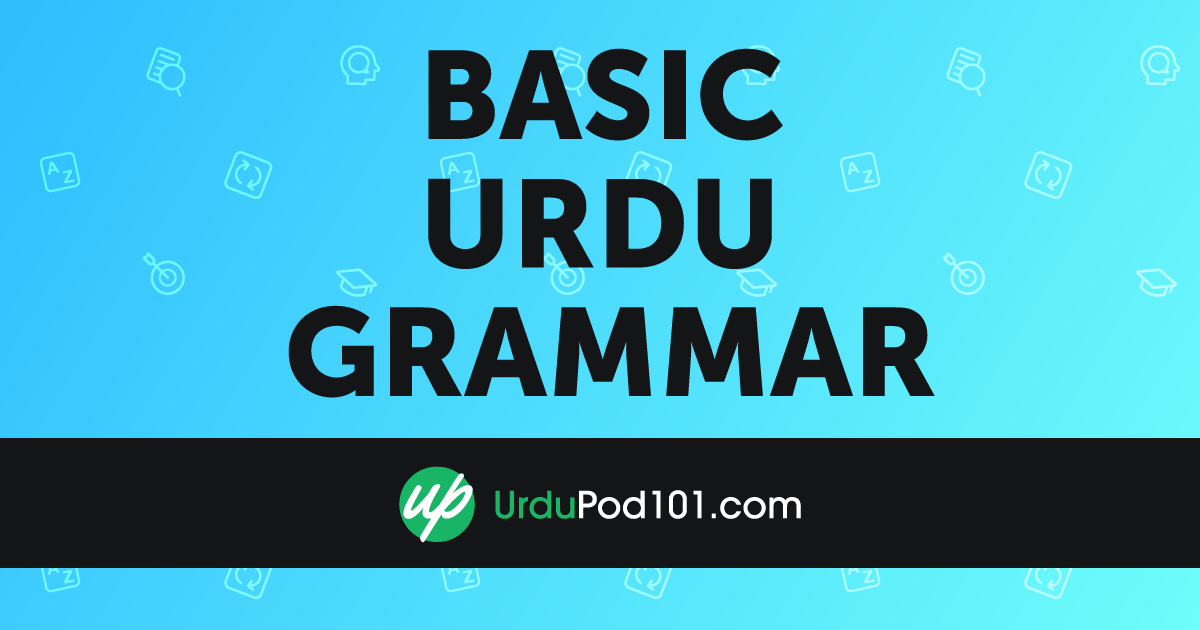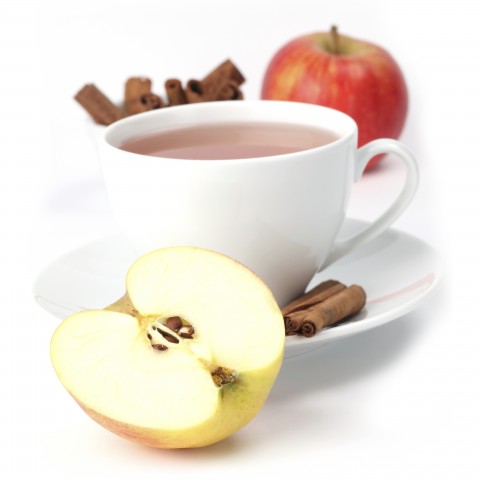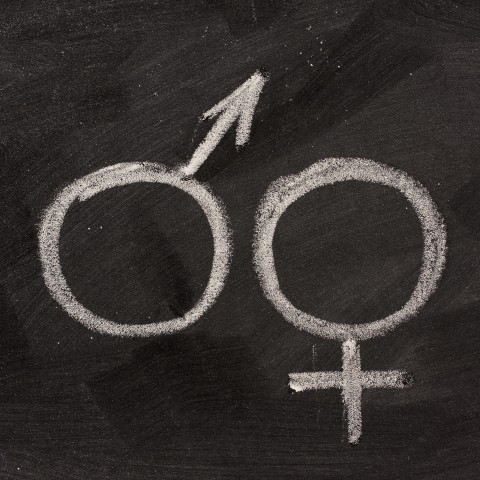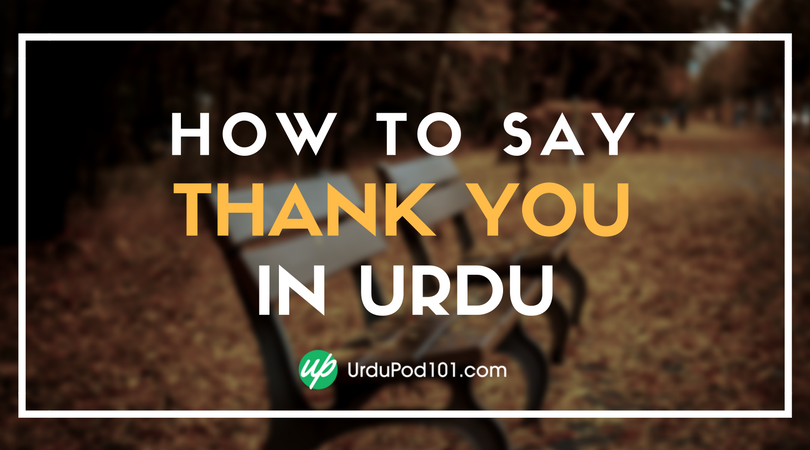
Edgar Allan Poe believed, “A man’s grammar, like Caesar’s wife, should not only be pure, but above suspicion of impurity.”
If you want to sanctify your Urdu grammar, you’re in the right place.
The structure of every language hinges upon its grammar. Having a basic understanding of a language’s grammar allows learners to fine-tune their listening comprehension and use the language clearly and accurately.
On this page, UrduPod101.com will inspire you to learn Urdu grammar in full by providing you with comprehensive overviews of the Urdu grammar basics and showing you how everything falls together.
 Table of Contents
Table of Contents
- The Urdu Script and Transliteration System
- Urdu Syntax and Word Order
- Verbs and Tenses
- Nouns
- Pronouns
- Adjectives
- Negation
- Interrogation
- Conclusion
1. The Urdu Script and Transliteration System
Urdu is a complete language with a unique script. It borrows its script from two widely popular oriental languages: Persian and Arabic. خطِ نستعلیق (khat-e-Nastaliq) is the standard Urdu writing system, which emerged from a mixture of two different writing scripts called Naskh and Talique. As a rule, you’ll find it written from right to left (instead of left to right, like in English). This writing script includes thirty-eight letters and ten vowel marks (called airaabs).
- → UrduPod101.com uses a comprehensive system of Urdu transliteration for your convenience. If you want more information on how this works, visit our dedicated page.
2. Urdu Syntax and Word Order
As an English speaker, you’re probably used to the SVO (Subject + Verb + Object) word order. Well, in Urdu grammar, sentences follow the SOV (Subject + Object + Verb) order, where the verb and object switch places.
Urdu is called a ‘verb final’ language because, syntactically, the verb comes at the end of the sentence.
To understand this properly, have a look at the following example:
میں چائے پیتا ہوں۔
mei chaye peeta hun.
Subject + Object + Verb
In English, this sentence would be:
I take tea.
Subject + Verb + Object
The word order will take some getting used to, but with enough practice and exposure, it will become second-nature to you.

I take tea.
3. Verbs and Tenses
In Urdu grammar, verbs are rather complex. That said, it’s generally best to start learning the Urdu verbs in their basic (infinitive) form.
Urdu Infinitives
Urdu infinitives always end with نا (na):
- بولنا (bolna) – “to speak”
- ہنسنا (hansna) – “to laugh”
- دوڑنا (dodhna) – “to run”
See our article on the 100+ Must-Know Urdu Verbs on UrduPod101.com to learn the most common verbs and how to use them.
The Conjugation of Urdu Verbs
Once you’ve learned a good number of Urdu infinitives, you’ll be better placed to start learning how to conjugate them. We’ll admit that Urdu verb conjugation is pretty complex, but there are several keys to it that will make the process simpler for you over time.
Urdu verbs conjugate according to the tense, person, number, gender, and mood. For the purposes of this overview, we’ll discuss the two most important factors: tense and gender.
Tenses
In Urdu grammar, tenses affect conjugation in a consistent manner. To see what we mean, study the example given below.
سونا (sona) is the base for the Urdu verb that means “to sleep.” Now, let’s have a look at how it conjugates in the present, past, and future simple tenses.
وہ سوتا ہے۔
woh sota hai.
“He sleeps.”
وہ سویا۔
woh soya.
“He slept.”
وہ سوئے گا۔
woh soye ga.
“He will sleep.”

Gender
Gender also plays a vital role in the conjugation of Urdu verbs. Let’s see how gender affects the conjugation of سونا (sona), or “to sleep.”
Male:
میں سوتا ہوں۔
mein sota hun.
“I sleep.”
Female:
میں سوتی ہوں۔
mein soti hun.
“I sleep.”
You can see that the English translation of the sentence remains the same, while the gender of the subject has conjugated the verb in Urdu.
To learn everything about verb conjugation in Urdu, visit our Urdu Verb Conjugation article on UrduPod101.com.

4. Nouns
Now that we’ve talked about verbs and their conjugation, let’s spend some time discussing the Urdu nouns.
Every Noun Has a Gender
Remember: In Urdu, every noun has a gender. This means that it’s necessary for foreigners to learn the nouns with their proper gender.
For example:
- کرسی (kursi) – “chair” [feminine]
- میز (maze) – “table” [masculine]
Once you acquire the skill of using Urdu nouns properly, it means that you’ve covered a long distance in your learning and aren’t very far away from total mastery!

Noun Types and Placement in Sentences
The two basic noun types in Urdu are:
- اسمِ نکرہ (isme nakirah) – “common noun”
- اسمِ معرفہ (isme marfa) – “proper noun”
They play the same roles in Urdu as their counterparts do in English. Normally, Urdu nouns are placed between the subject and verb of a sentence.
To know more on this topic, read our Urdu Nouns article on UrduPod101.com.
5. Pronouns
Just like English pronouns, Urdu pronouns play a significant role in the structure and function of sentences. They replace nouns that are mentioned more than once in order to avoid repetition.
Basic Types of Urdu Pronouns
Urdu uses many of the same pronoun types as English does. For example, you’ll find the following groups in Urdu:
- ضمیر متکلم (zameer mutkallam) – “first person”
- ضمیر حاضر (zameer hazir) – “second person”
- ضمیر غائب (zameer ghayab) – “third person”
The Special Case of تم (tum) and آپ (aap)
In Pakistan, always be vigilant when using the second person pronoun “you,” which can be translated two ways: آپ (aap) and تم (tum). You must use the former with people you don’t know, the elderly, or those who are above you in status; it sounds the most respectful and formal. Use the latter only if you’ve developed a high level of intimacy with the other person. Otherwise, you may face some serious repercussions.
To explore this topic further, read our Urdu Pronoun article on UrduPod101.com.

6. Adjectives
Like those in English, Urdu adjectives describe nouns and thus are a crucial element of Urdu grammar. Let’s have a cursory look at the nature and function of Urdu adjectives.
The first thing that you must learn is that the gender of an adjective is determined by the noun:
- گہرا دریا (gehra darya) – “deep river”
- گہری نہر (gehri nehar) – “deep canal”
In the first example, the adjective گہرا (gehra) is used in masculine form because the noun دریا (darya) is masculine. In the second example, the adjective گہری (gehri) is used in feminine form because the noun نہر (nehar) is feminine. Thus, you can see how Urdu adjectives must agree in gender with the noun they describe.
Also remember that Urdu adjectives are normally placed before the nouns they describe.
7. Negation
In the Urdu language, نہیں (nahi) and نہ (nah) are the most important words of negation. They are equivalent to “no” or “not” in English. Being able to use these words of negation in your own Urdu sentences is a huge milestone, as it will allow you to communicate more complex thoughts.
Here are a couple of examples of how these words can be used:
یہ نہ کرو۔
yeh na karo.
“Don’t do this.”
میں تم سے ناراض نہیں ہوں۔
mein tum se naraz nahi hun.
“I am not angry with you.”

8. Interrogation
You can hardly imagine a conversation without questions, right? Let’s look at how to form questions in Urdu!
Words of Interrogation
The first step is to memorize the question words in Urdu. These are:
- کیا (kia) – “what”
- کیوں (kyun) – “why”
- کب (kab) – “when”
- کہاں (kahan) – “where”
- کیسے (kaise) – “how”
Using These Words in Questions
Got it? Great! Then let’s see how to form interrogative sentences with them.
You can form questions by placing the appropriate question word at the beginning of the sentence or after the subject.
کیا تم خوش ہو؟
kia tum khush ho?
“Are you happy?”
تم کیسے ہو؟
tum kaise ho?
“How are you?”
تم کیوں ناراض ہو؟
tum kyun naraz ho?
“Why are you angry?”
تم کہاں ہو؟
tum kahan ho?
“Where are you?”
تم کب آؤ گے؟
tum kab aaoge?
“When will you come?”

9. Conclusion
We’ve now guided you on the basic Urdu grammar rules. You can always use this concise Urdu grammar guide as a quick reference point for your Urdu learning in the future.
How do you feel so far? If you have any questions or concerns about something we covered here, don’t hesitate to let us know! We’ll be glad to help you out. And if you feel like you need to go over this information with fresh eyes, check out our lesson Painless Urdu Grammar.
If you enjoyed this lesson and want to learn more with us, feel free to explore UrduPod101.com. We are a rich repository of Urdu language learning resources designed to enhance your Urdu vocabulary, pronunciation, and other relevant skills.
Very Happy Urdu Learning!










